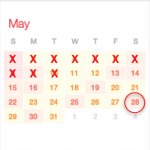20-Dialogues-In-20-Days
The At-Home Couples
Communication Training Program
Developed by Barbara Reichlin, MA, LMFT, LPC
20-Dialogues-In-20-Days is a simple communication training program that utilizes the Imago Dialogue to offer couples a path to building better communication skills in the privacy of their own home. The goal, which is to help partners replace their normal way of dealing with conflict with the conscious tool called the “Imago Dialogue”, (usually shortened to “Dialogue”), is achieved gradually via daily repetition of brief dialogues on carefully chosen, safe topics. Only after several weeks of practice are couples invited to use their new skills to discuss problem issues.
Introduction
Ever hear the adage that it takes doing something everyday for 21 days to develop a new habit? Turns out, that’s a myth.
Actually, according to a reliable 2009 study, it takes, on average, 66 days to form a new habit, and longer for more difficult behaviors. When you compare this with the fact that people entering into recovery programs are told that if they are serious about changing their lives, they need to do “90 meetings in 90 days”, you begin to realize the amount of effort and commitment it will take most couples to change their communication style.
It simply stands to reason that couples wishing to develop better communication skills via the Imago Dialogue must practice it time and again until the steps are memorized and that awkward stage experienced when learning any new skill, has passed.
Introducing . . .
20-Dialogues-in-20-Days! (“20-in-20”)
The At-Home Communication Training Program for Couples
Overview:
Each day for 20 days, partners take turns being the sender in a brief dialogue, using a topic from the Dialogue Topics Guide. While the first partner, (Partner A), “sends”, the other mirrors, validates and empathizes. When done, Partner B gets to respond, if desired, to A’s “send” and then has a chance to send their own message about that day’s topic. When done, Partner A says if they would like a chance to respond to Partner B’s send.
Step One: Review/print the basic steps of the Imago Dialogue
If you have not already done so, print 2 copies, (one for each of you), of each of the following. Read them over.
• Dialogue Instructions for the Sender
• Dialogue Flowchart for the Sender
• Dialogue Instructions for the Receiver
• Dialogue Flowchart for the Receiver
Step Two: Print out the 20-Dialogues-In-20-Days Training Program Topics.
Step Three: Decide who will start things off on Day One.
The program is designed so that responsibility for bringing up each day’s dialogue is equally shared. One partner initiates on even numbered calendar days, the other on odd numbered calendar days. Each person initiates on their designated days, WHETHER OR NOT THEIR PARTNER INITIATED THE DAY BEFORE. See below for hints on handling common initiation stumbling blocks.
Step Four: Decide when might be a good time each day to dialogue.
It’s actually difficult to do any new behavior every day – especially when it involves two people’s availability. Our lives, feelings, energy levels, etc., simply vary too much from day to day. So while most people can do the dialogues, finding the time and getting started each day can prove challenging.
The chances of success will be greatly enhanced if you can pair your daily talk with another regularly occurring activity: e.g., while taking a walk, making or eating dinner, after the kids go down, lying in bed before going to sleep, etc.
Step Five: Begin and keep it going.
After reviewing the downloaded pages, Partner A initiates the first dialogue. In the beginning, use the Dialogue Receiver and Sender Flowcharts as your guide. Once you are comfortable with the dialogue, you can put these aside so your talks will feel more natural.
___________________________________________
FAQ’s
Most questions regarding the 20-in20 program will be answered here, but if not, please feel free to email Barbara at breichlin_at_swbell.net.
• How should we initiate? Each day, the initiating partner begins by either a) asking if this is a good time to do the dialogue (e.g., “Do you want to do our Dialogue now?”), or b) by simply volunteering a “send” about the day’s topic. If Partner B doesn’t mirror spontaneously, Partner A should playfully request them to do so.
• What if my partner doesn’t spontaneously mirror, validate or empathize?
This happens, of course. You probably won’t always remember to do each step, either. You can help each other stay in process by asking the Sender these simple questions: (always with a smile in your voice) 
• “Can you just mirror/say back what I just said?” (Mirroring)
• “Is what I’m saying making sense to you?” (Validation)
• “Can you understand how I might be feeling?” (Empathy)
• I find it hard to initiate. How can I get myself to stay on course?
The best advice: keep reminding yourself why you are doing this. You WANT a better relationship, yes? You want more PEACE, less fighting, more closeness, safety and respect, yes? Perhaps you want a better relationship for your kids sake or because you fear the loss of your marriage if you don’t learn to communicate. Whatever your motivation, write it down and POST IT where you will see it DAILY!
• What if one of us just doesn’t initiate?
In some relationships, one person may end up becoming more the initiator simply because they find it easier, or at least easier than their partner, to do so.
Barbara’s STRONG RECOMENDATION:
If the low (or lower) desire partner is willing to participate once things get going, and if their initiating is not a core issue for the other, then perhaps initially (for the first couple of weeks or so), the higher desire partner will be willing to stretch into carrying more of the initiation load knowing that the other’s stretch will be in doing the exercise. (After all, it’s not really reasonable to expect someone to suddenly go from a lifetime of rarely talking about themselves or their feelings to not only talking daily but initiating as well!) However, by week three, the low desire partner should be initiating at least a third of the time.
• How long should we talk?
Dialogues need not last more than 10 to 15 minutes. (Warning: many couples report taking up to an hour simply because once they start talking together, they find they’re enjoying it so much, they want to continue.)
• Do we talk about our “issues”?
No, not in the first 2 weeks. You are in “Dialogue Training” and will not be ready to tackle an issue until you have had at least 14 days of practice.
 • What if we miss a day?
• What if we miss a day?
If you miss a day (and of course, this will happen,) simply pick back up where you left off the following day. It’s more important to do all 20 dialogues than it is to do them in exactly 20 days.
• Can we skip around in selecting a topic?
The topics are arranged to keep a balance between light and somewhat more serious topics. You can, of course, choose to skip around. The only caveat is to postpone discussion of relationship topics that have negative energy around them until you have completed roughly fourteen dialogues.
Feedback for Barbara: Your willingness to send me feedback on how this goes, (Including quotes I might use on this page) will be extremely appreciated and helpful to others. Just drop me an email at breichlin_@_swbell.net.
Thank you!

